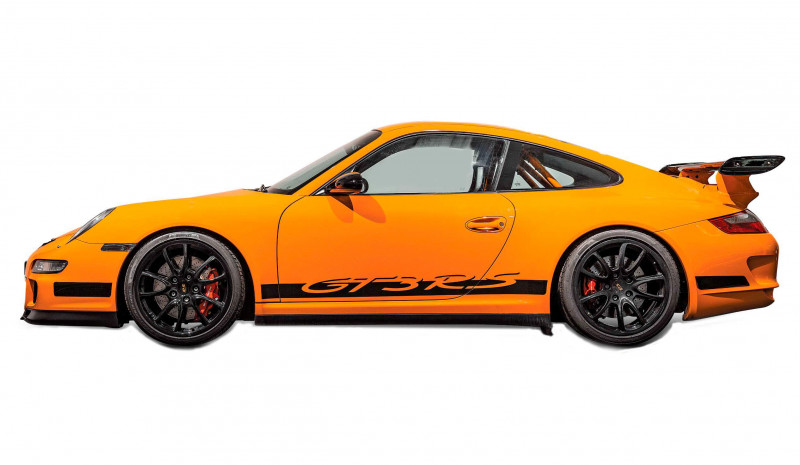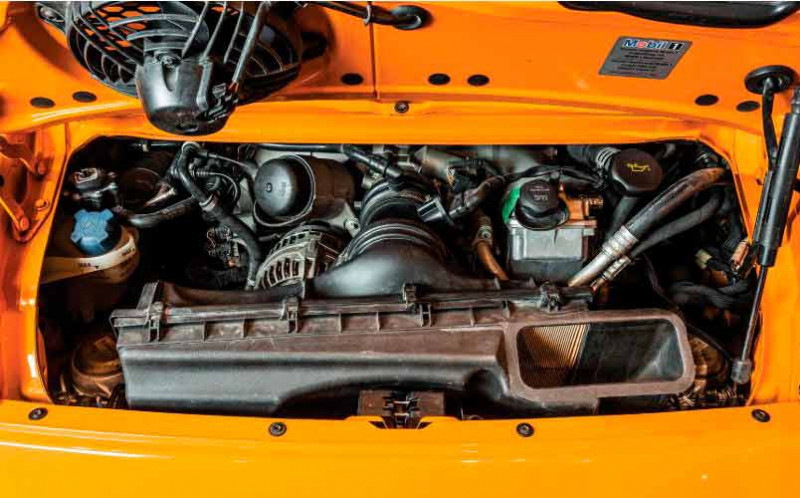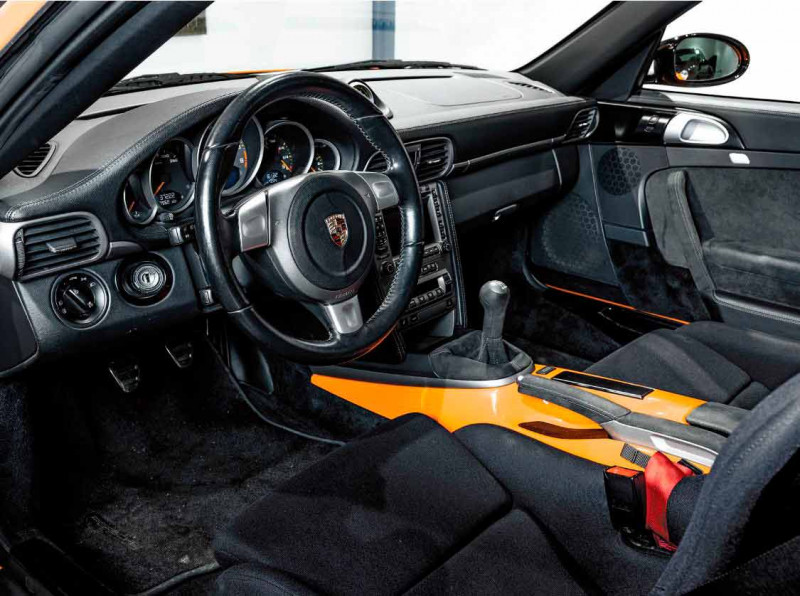Buyers Guide Porsche 911 GT3 RS 997.1

A largely undervalued modern Rennsport, the 997.1 represents a surefooted investment right now. Here’s everything you need to know about it index: 997.1 GT3 RS Written by Kieron Fennelly
Porsche Index: 997.1 GT3 RS
Your ultimate guide to the most underrated Rennsport of the modern era
HISTORY AND TECH
The 997 GT3 was launched at Geneva in March 2006 and, as with its 996 GT3 and 993/964 RS predecessors, it was designed to homologate the 997 for the Porsche Cup and from 1999, GT3 class. At Geneva, Porsche also presented the GT3 RS, which looked to all intents and purposes like a GT3 with an aero kit. However, the RS was rather more than that, as we're about to find out.

Apart from its bold side decals and green or orange paint schemes, the main visible differences with the GT3 were the carbon wing which stood proud on two wide struts, and the RS’s more prominent hips. The RS used the same wheels and tyres and mostly the same suspension as the GT3, but to accommodate its 3cm wider track, Porsche employed the wider Carrera 4 body. At the front, the RS’s very low front skirt was said by project leader Andreas Preuninger to increase downforce by 15kg more than the GT3’s spoiler, and the specific rear wing improved downward pressure by 25kg, although this started to sound a shade theoretical when he explained that these measures applied at 300kph.
Nevertheless, the 997.1 RS was conceived essentially for the track and practiced exponents could certainly feel the improvements in stability on a fast circuit like Spa, though its Nürburgring time at 7:42 was only four seconds quicker than the plain GT3’s.

Mechanically, the RS shared the GT3 engine, a development of the 996 GT3 ‘Mezger’ which had been considerably reworked. Longer connecting rods meant slightly short pistons could be used, reducing reciprocating mass and allowing the rev limit to be raised by 200rpm to 8,400rpm. Throttle diameter was enlarged and the VarioCam timing increased by 7° to give a 52° range, which improved the torque curve. A freer-flowing exhaust, which was now channelled through one large silencer rather than two, lowered back pressure. On the dynamometer the 3.6 now yielded 415PS with peak torque of 403Nm, an astounding set of figures for a production engine described as ‘bulletproof’ to 9,500rpm. Both GT3 and RS used a version of the 993 GT2’s six speed gearbox with slightly lower ratios to take into account their 19-inch wheels. The RS also had a single-mass flywheel.
The RS’s interior was much as the GT3’s with Alcantara headlining, gear knob and steering wheel. The front lid was in carbon fibre and the rear window in plexiglass, seen as somewhat symbolic attempts to save weight. Porsche homologated the RS without a/c but with a roll cage at 1,380kg.
“Practiced exponents could certainly feel the improvements in stability on a fast circuit like Spa”
WHAT’S IT LIKE TO DRIVE?
For anyone used to older, say pre-2011 911s, any GT3 is a revelation and the 997 RS even more so: the cockpit with bucket seats, Alcantara wheel and yellow stripe marking top dead centre, and a rear cabin unadorned, except filled by a roll cage, all suggest a very special 911. On the road, the sensation is that of a 997 C2S magnified by ten: throttle response is instant, the steering feels slightly meatier, but is even more direct, the clutch is heavier, and the gearshift, which has rifle-bolt precision, needs a firm hand. There is no thought of looking for a radio: even low-speed manoeuvres in this car require concentration. The cabin is hardly quiet, the gearbox chattering away undamped by the single-mass flywheel and the potent if not especially attractive engine note at low revs; it does, however, suggest great energy, which could easily get out of hand. When that long-travel throttle is depressed for more than a couple of seconds, the RS takes off. In a full-bore start in the 3.6 RS, first and second gears disappear in a blink, the driver’s concentration so absorbed in clutch and shift that only in third is there a moment to listen to that primeval engine note as it rises towards its sensational 8,400rpm crescendo.

The 997 GT3 and RS benefitted from PASM, which allowed them to be stiffened for the track but makes them, unlike the 996 RS, a 911 that can comfortably be driven to Spa. But cabin refinement is limited and clearly the vocation of the GT3, and even more the RS with its perilously lowslung front, is not for grand touring, and for this the plain 997 is a more comfortable companion.
ABOVE The 997.1 GT3 RS is a big step on from the 996 in terms of downforce and airflow management
THE VALUES STORY
The 997 RS retailed at £94,280, some £14,700 above the base GT3. Porsche planned to build about 1,100 of the RS, roughly a third of the quantity of Gen1 GT3s over the same period. The RSs suffered some initial depreciation, no doubt fanned by commentators not convinced by the price difference with the GT3 (the Gen2 RS of 2010 would offer a more substantial upgrade over the base GT3). Depreciation of the 997.1 RS saw values at 25% below the original retail price at their lowest point. Paragon had an example for sale in 2013 at £75,000, the beginning of a steepening appreciation curve which peaked as with most rare or specialist 911s in 2016, after which prices cooled for a year or two, only for the RS to resume a steady upward trend. Today an exemplary 997.1 GT3 RS from 2006-8 makes between £130-£140,000. Ashgood Porsche reckons prices have increased a good 15% since 2018.
BUYING ONE
Any GT3 is a specialist purchase. For most people even with the softer PASM setting, the 997’s ride is almost too firm for everyday use on British roads. With the wider RS, which does not have the lifting mechanism of the later 991 RS, it is difficult not to catch the spoiler on humps. Cabin and luggage space are less than the Carrera’s and a 997S/991S would be far more versatile, but for the track day enthusiast well acquainted with Porsches, the 997.1 RS will not be a disappointment. Of course, the current GT3 (the RS is still anticipated) is in another league dynamically, but the appeal of the 997 version is it's still almost entirely analogue nature, combined with the smaller dimensions of the 997, allow the driver almost the same level of visibility as the air-cooled 911s do.
Although the 997 GT3 RS is a 15-year-old car in Gen1 guise, few of these cars have covered high mileages. Mostly they will have been stored for long periods (almost always under cover) and this does no harm, says Jason Shepherd of Paragon, provided the engines are turned over regularly to lubricate seals, though ideally, they would be driven far enough to bring the oil up to operating temperature, and of course, never failing to warm the oil properly before using the higher rev range. For such a potent unit, Shepherd thinks the Mezger is amazingly robust, not requiring intensive or complex maintenance provided it is looked after. If the RS has a track history as the vast majority do, it is important to see that oils (both engine and gearbox) have been changed according to Porsche’s specific competition maintenance schedule, which also includes brake fluid. Other items for buyers to have on their checklists are the usual consumables from coolant and a/c radiators to brake materials, tyres and dampers. Evidence of a recent geometry test to ensure everything is operating within its designated parameters is a must. The now retired GT3 guru Steve Hales always used to say that a car with incorrect geometry is like a wobbly pub table. Unfortunately, a couple of beer mat shims will not suffice for a Porsche!
Jason Shepherd points out that especially with these relatively rare, exotic 911s, the wisest recourse is to a specialist unless the buyer knows the car. Firms like Paragon will buy and sell the same 911 several times and generally will only take back cars if they have been maintained in the state in which they sold them. “We make exceptions inevitably. We acquired a smart 997 Turbo, but found we had to spend over £15,000 to put it out in a condition we were happy with. On the other hand, the orange 997 RS we have (at £140,000) is spotless and is a car we know well. You could buy a GT3 RS 3.6 for £120,000, but I suspect you could end up spending a good chunk more to bring it up to standard.”
ABOVE The RS's interior is similar to the GT3, but its drive is unquestionably different.
INVESTMENT POTENTIAL
Paragon’s view, seconded by Ashgood, is that interest in Porsche racing history has never been higher and simply the number of column inches a new GT3 or GT3 RS generates is a measure of this fascination. The interest in the earlier cars, says Jason Shepherd, has a lot to do with their mechanical, analogue nature, which contrasts with the increasingly automated future of personal transport and electric cars. The special, low-production 911s have always remained valuable: the 2.7 RS is the most famous example, but the 993 RS, of which 1,100 were made, has quietly passed £250,000 and the 996 RS (682 made) has now reached £150,000. While no one would say that the first-generation 997 GT3 RS was the next 2.7 RS, it is a special enough 911 to consider a reasonable investment as any. But shame on anyone buying it simply to put in a climatised vault!
BELOW The 997.1's wider body, manually adjustable rear wing and centre exit exhaust would all become hallmarks of Porsche's modern Rennsport DNA
DRIVES TODAY VERDICT
The 997 is now viewed as the last properly analogue 911. The GT3 RS takes all the 997’s virtues of performance and agility and magnifies them by a factor of ten. The Gen1 was the first of three 997 RSs, each more stunning than the last, culminating in the legendary 4.0 RS. Compact and driver-focused, accessible to ordinary driving skill levels yet a delight for the expert and powered by one of the greatest production engines ever made, the 997 RSs represent the ultimate pre-electronic sports cars. The Gen2 costs a good 25% more without being 25% better and the value of the RS 4.0 puts it out of reach, well into the collector’s sphere, making the first-generation 997 RS the best value.
DESIRABLE OPTIONS
The standard specification of the Gen1 997 RS was comprehensive for a car intended for such a specific purpose: bucket seats, Alcantara fittings, single-mass flywheel, manually adjustable suspension as well as PASM dampers. A roll cage, usually fitted anyway, is worth having simply for the stiffening it lends to the shell; a/c was a no-cost option, but given any 911 is like a greenhouse as soon as the sun comes out, it really is a must. Colours other than the vivid green or orange were available, at a price: paint-to- sample cost £2,180. Porsche’s (ultra) light bucket seats cost £3,130.
MARKET RIVALS
In mid-2021, the going price for a RHD 997.1 GT3 RS is about £140,000. In this slightly lonely price bracket, much 911 pricing falls 15% below or 30% higher.…
- 992 Carrera S £120,000 suffices for the latest, fully specified 3-litre (turbocharged) 911 with delivery mileage. A superbly developed GT with performance figures comparable with the 997 GT3’s and with optional manual gearbox, it is however likely to depreciate significantly in Porsche terms.
- 991 Turbo S £130,000 should suffice to glean the very last of the line, a 2018 coupé with nominal mileage. Another outstanding GT, wanting for nothing with 580PS, which again will depreciate fairly steeply. £140k would buy a very low-mileage Turbo S Cabriolet.
- 964 RS Spiritually the predecessor of the GT3 RS, the 964 version was a lowered, equipment-reduced, raw 964 which acquired a huge following (and commensurate rise in value) back in the early 2000s. £180k buys a very serviceable if not concours example.
- 991.1 GT3 RS On sale ten years after the 997 RS, the 991 edition feels far more modern for our nominal £140k. Its naturally aspirated 3.8 is even more explosive than the Mezger, and PDK makes it easier to drive, but the wider 991 platform and more extensive aero can be awkward in confined spaces.

